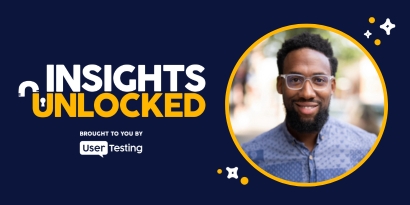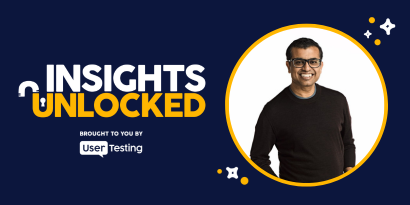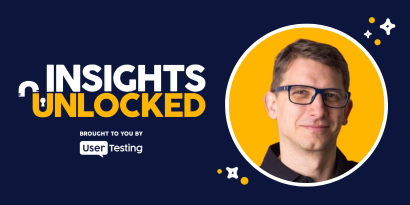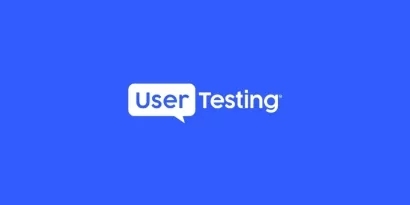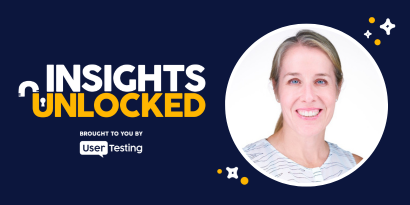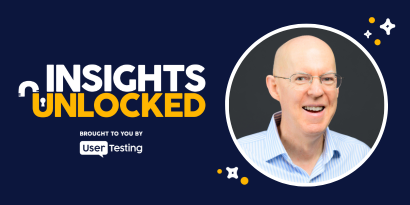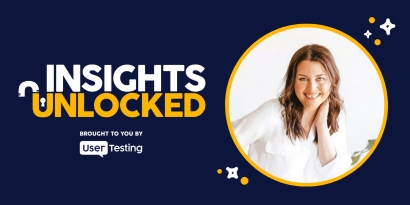
Episode 50 | July 26, 2022
Eye tracking in UX research with Andrew Schall
Discover how eye tracking enhances UX research with Andrew Schall of Mayo Clinic. Learn when, why, and how to use this powerful method for deeper insights.
The untapped power of eye tracking in UX research
Most UX teams rely on what users say and do—but what if you could also see what they see? Eye tracking in UX research makes that possible, revealing attention patterns that are invisible to traditional testing.
In episode 50 of Insights Unlocked, Andrew Schall, Senior Director of Experience Design Research at Mayo Clinic, explored the strategic role of eye tracking and why it belongs in your research toolkit.
Seeing is believing: what eye tracking adds
Andrew describes eye tracking as a way to "see things from the user's perspective quite literally." By tracking eye movements, UX researchers can identify what captures attention, where confusion arises, and which parts of a design go completely unnoticed.
From a technical standpoint, eye tracking measures fixations—brief moments when the eye pauses to process information. These data points form the basis for three common visualizations:
- Gaze plots: Show the path of the user’s eyes, ideal for understanding behavior at the individual level.
- Heat maps: Aggregate the visual focus of multiple users for quantitative insights.
- Gaze replays: Video-based playback of where users looked, offering deep behavioral context.
Andrew finds gaze replays particularly compelling: “I can see what the person was trying to do as they're doing it… it brings everything together.”
ON-DEMAND WEBINAR
Tactical (and practical) tips to get fast feedback for better marketing
Timing is everything
Despite its potential, eye tracking isn’t meant for every stage of the product development cycle. According to Andrew, it’s most effective once the design is “fairly well baked.” Early-stage prototypes are too volatile, with design tweaks like color or placement shifts having outsized influence on eye movement.
“You want to apply it much later in the design process,” he said. “It’s really about evaluating visual hierarchy and usability.”
Eye tracking provides clarity on what works visually and what doesn’t—making it ideal for validating design decisions just before launch.
Eye tracking in the real world
Modern UX research isn't confined to screens. Andrew and his team use wearable eye tracking glasses to evaluate real-world experiences, such as navigating a hospital using a wayfinding app.
“The glasses are basically capturing everything—whether they’re looking at the phone or their environment,” he explained. This hybrid view helps uncover how users switch attention between digital interfaces and physical spaces, making it ideal for mobile eye tracking and customer experience design projects.
Stakeholder buy-in through visuals
One surprising benefit of eye tracking is how well it resonates with non-researchers. Watching someone’s eye movements in real-time during a test leaves a lasting impression on designers and stakeholders.
“There’s nothing like seeing a designer’s reaction to where a person is looking in their design,” Andrew said. “It connects them more deeply to the research.”
Whether you're deciding where to place a button or evaluating signage, eye tracking brings clarity to questions that often stall teams.
Wrapping up: more than meets the eye
Eye tracking is a game-changer for user behavior analysis, offering a level of insight that complements—but doesn’t replace—traditional usability testing. It tells you what happened, and when paired with interviews, it can help you figure out why.
As Andrew put it, “It’s cool technology… and that data’s going to keep being utilized over time.”
Episode links:
- Take your research to the next level: This webinar explores how to elevate UX research by connecting with users' real-world experiences. It emphasizes strategic research objectives and aligning studies with key business initiatives, resonating with the episode's discussion on the strategic application of eye tracking in UX research.
- The UX research reckoning one year later: Insights from Judd Antin: In this Insights Unlocked episode, Judd Antin discusses the future of UX research, including the role of methods like eye tracking in understanding user behavior. The conversation complements the original episode's exploration of eye tracking's value in UX research.
- Eye tracking: Where it's been and where it's going: This blog post traces the history and evolution of eye tracking technology, discussing its applications in UX research. It provides context and depth to the themes discussed in the podcast episode.
